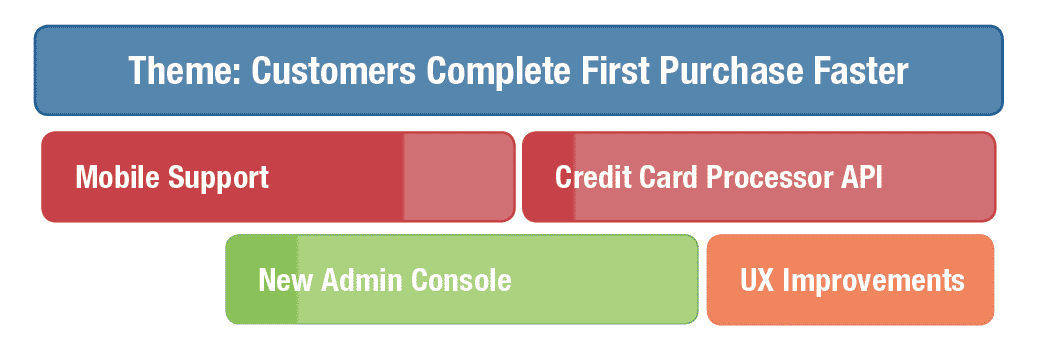You don’t often see political candidates using bumper stickers and campaign slogans like, “Vote for me, and together we can repeal H.R. 1721, Sub-Section 4.1(b)!”
Candidates for the political office almost always choose easy-to-digest themes, such as “Let’s Put America Back to Work,” or “Make Our Country Strong Again,” or “Prosperity Through Unity.”
There are many good reasons for organizing a political campaign — or driving a product or customer initiative — around “themes,” or high-level strategic objectives. For example:
- Themes quickly and clearly communicate your “why” — your overall strategy or goal.
- Themes appeal to emotion, a highly effective way of earning audience buy-in.
- Themes help keep everyone focused on a single objective, regardless of what parts of the initiative they are working on.
- Themes can bring out ideas and creativity across the team, which likely would not surface if the people working on the initiative could see only a series of disjointed tasks and not a big-picture goal.
Example Themes
To give you a better idea of how themes fit into roadmaps, and how product managers can use themes to their advantage in a number of ways, let’s walk briefly through a couple of examples.
Theme 1: “Make the product easier to try and buy.”
Now there’s a useful theme! To be sure, though, let’s check it against our list above of value propositions for themes in general.
Does this theme quickly and clearly communicate a strategic objective, a “why”? Check. Does it appeal to emotion? Check. Who could argue with making your product easier to try and buy? Will it help everyone involved stay focused on a single objective throughout the process? Check. And will it bring out more creative energy from your teams because they understand what their individual tasks are ultimately designed to accomplish? Perhaps, perhaps not. But the chances of this happening clearly better than if everyone was working on their specific jobs not fully knowing what you were hoping to achieve.
This theme will have many sub-sections — “epics,” “stories,” “features.” For example, one focus of making the product easier to try will be to streamline the trial sign-up experience on your website. Perhaps it now takes several screens and answering many questions to complete the sign-up. Perhaps the user even has to input credit card information at this stage.
Also, for the second part of our theme — making the product easier to buy — one story might be to improve the follow-up communication process, making follow-up emails shorter and more directed to a simple purchase experience.
Now all of your constituents and stakeholders can see the “why,” the strategic reason for shortening the post-sign-up emails, a shorter trial sign-up process, the removal of the credit card step at the trial level, etc.
How Themes Can Protect Your Initiative From Getting Off Track
Now let’s imagine you’re presenting your roadmap to the marketing team, to bring them onboard with your request to update the communication process for anyone who signs up for the trial version. The team understands what you’re trying to accomplish, and they are enthusiastic about revamping the follow-up emails with this new objective of making the whole process easier for the customer.
But then the marketing VP suggests that the new sign-up procedure will be a great chance to include a few survey questions. He even has a solid reason: It will allow his team to more appropriately tailor their follow-up emails.
Your answer? No.
Why? Because as much as you’d like to use this captive-audience moment to gather user information, it will go against your theme — to make the product easier to try and buy. And because you have such a clear theme, your marketing VP understands your reasoning.

Theme 2: “Create a great ATM experience for our customers.”
This theme, for a product manager in the consumer banking industry, also provides a useful framework to help drive a successful initiative.
It’s a clear way to explain a strategic goal, under which all of the disparate tasks and feature requests will have real context. It can earn the needed buy-in from stakeholders and constituents because it appeals to them on an emotional level. And it will help keep everyone involved focused on a big-picture objective, rather than allow them to get lost in the details and complete their portions of the initiative without fully understanding why.
What are some of the stories that might fall under this theme to create a great ATM experience?
- Combine several of the screens to make the whole experience faster.
- Make receiving cash the final step in the experience, so the customer can leave immediately when they have cash in hand.
- Change the card process, so that the machine returns the customer’s card immediately after processing the PIN.
All of these details are logical in their own right and might even have evidence to support their implementation. Kicking out the customer’s card immediately, rather than at the end of the transaction, might be required because customers often forget that their cards are still in the machine, and leave without them. Holding the cash until the final step makes sense for security reasons.
But each of these stories, and the individual tasks that will follow from them, will be clearer and more persuasive if they all roll up to a strategic, easy-to-understand theme like “Create a great ATM experience for our customers.”
Themes Can be a Valuable Tool for Better Roadmaps and, Ultimately, Better Products
Because they have to communicate their product’s strategy and plans to many different groups, product managers often have difficulty ensuring they are presenting the right level of detail and using the proper focus, to resonate with each constituency. Getting this wrong can have serious, negative consequences for the initiative.
Present a roadmap to executive stakeholders that delves too quickly and too deeply into the individual features — without first communicating the strategic or financial value to the company — and the product manager risks losing buy-in needed to move forward. Focus entirely on project tasks and timelines in a product meeting with developers — without first orienting everyone around the big-picture reason they’ll be taking on these tasks — and the product manager will have at best an unenthusiastic team and at worst a confused one.
This is why it is so valuable to build your initiatives around a central theme — a strategic guide, or hook, that brings together all of the downstream stories, tasks, features, and other details. Themes can work universally — with developers as well as executive stakeholders, with marketing and sales teams as well as your customers.
Starting with a high-level theme is like letting your constituents know right away, “This is why we are going to be taking on all of the details we’re about to discuss, in the order I will be proposing them.” It’s also the fastest, simplest way to reach your constituents on an emotional level and bring them over to your side.
And finally, when the inevitable happens — and someone proposes a deviation from your plan, even for a good reason — your theme can serve as a guidepost to remind them of the original strategic objective.



